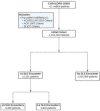Identification and assessment of classification criteria attributes for systemic lupus erythematosus in a regional medical record data network
- PMID: 37857531
- PMCID: PMC10603333
- DOI: 10.1136/lupus-2023-000963
Identification and assessment of classification criteria attributes for systemic lupus erythematosus in a regional medical record data network
Abstract
Objective: To assess the application and utility of algorithms designed to detect features of SLE in electronic health record (EHR) data in a multisite, urban data network.
Methods: Using the Chicago Area Patient-Centered Outcomes Research Network (CAPriCORN), a Clinical Data Research Network (CDRN) containing data from multiple healthcare sites, we identified patients with at least one positively identified criterion from three SLE classification criteria sets developed by the American College of Rheumatology (ACR) in 1997, the Systemic Lupus International Collaborating Clinics (SLICC) in 2012, and the European Alliance of Associations for Rheumatology and the ACR in 2019 using EHR-based algorithms. To measure the algorithms' performance in this data setting, we first evaluated whether the number of clinical encounters for SLE was associated with a greater quantity of positively identified criteria domains using Poisson regression. We next quantified the amount of SLE criteria identified at a single healthcare institution versus all sites to assess the amount of SLE-related information gained from implementing the algorithms in a CDRN.
Results: Patients with three or more SLE encounters were estimated to have documented 2.77 (2.73 to 2.80) times the number of positive SLE attributes from the 2012 SLICC criteria set than patients without an SLE encounter via Poisson regression. Patients with three or more SLE-related encounters and with documented care from multiple institutions were identified with more SLICC criteria domains when data were included from all CAPriCORN sites compared with a single site (p<0.05).
Conclusions: The positive association observed between amount of SLE-related clinical encounters and the number of criteria domains detected suggests that the algorithms used in this study can be used to help describe SLE features in this data environment. This work also demonstrates the benefit of aggregating data across healthcare institutions for patients with fragmented care.
Keywords: Epidemiology; Health services research; Lupus Erythematosus, Systemic.
© Author(s) (or their employer(s)) 2023. Re-use permitted under CC BY-NC. No commercial re-use. See rights and permissions. Published by BMJ.
Conflict of interest statement
Competing interests: ANK is a strategic advisor for Datavant. TLW receives research support from Gilead Sciences. RR-G has been a consultant to Exagen Diagnostics, ThermoFisher, Ampel Solutions, Calabetta Bio and Biogen (all less than $10 000) and none relevant to the current research project.
Figures

Similar articles
-
Comparing the 1997 update of the 1982 American College of Rheumatology (ACR-97) and the 2012 Systemic Lupus International Collaborating Clinics (SLICC-12) criteria for systemic lupus erythematosus (SLE) classification: which enables earlier classification of SLE in an urban Asian population?Lupus. 2019 Jan;28(1):11-18. doi: 10.1177/0961203318811599. Epub 2018 Nov 21. Lupus. 2019. PMID: 30463470
-
Comparison of systemic lupus international collaborating clinics 2012 classification criteria and European league against rheumatism/American college of rheumatology 2019 classification criteria for early detection of childhood onset systemic lupus erythematosus (multi-center study).Lupus. 2024 May;33(6):629-637. doi: 10.1177/09612033241240830. Epub 2024 Mar 27. Lupus. 2024. PMID: 38533912
-
Classification of Systemic Lupus Erythematosus: Systemic Lupus International Collaborating Clinics Versus American College of Rheumatology Criteria. A Comparative Study of 2,055 Patients From a Real-Life, International Systemic Lupus Erythematosus Cohort.Arthritis Care Res (Hoboken). 2015 Aug;67(8):1180-5. doi: 10.1002/acr.22539. Arthritis Care Res (Hoboken). 2015. PMID: 25581417
-
Diagnostic accuracy of the European League against rheumatism/American College of Rheumatology-2019 versus the Systemic Lupus International Collaborating Clinics-2012 versus the ACR-1997 classification criteria in adult systemic lupus erythematosus: A systematic review and meta-analysis.Front Immunol. 2022 Oct 12;13:1023451. doi: 10.3389/fimmu.2022.1023451. eCollection 2022. Front Immunol. 2022. PMID: 36311745 Free PMC article.
-
Advances in SLE classification criteria.J Autoimmun. 2022 Oct;132:102845. doi: 10.1016/j.jaut.2022.102845. Epub 2022 Jun 17. J Autoimmun. 2022. PMID: 35725680 Review.
References
-
- Bruce IN, O’Keeffe AG, Farewell V, et al. . Factors associated with damage accrual in patients with systemic lupus erythematosus: results from the systemic lupus International collaborating clinics (SLICC) inception cohort. Ann Rheum Dis 2015;74:1706–13. 10.1136/annrheumdis-2013-205171 - DOI - PMC - PubMed
Publication types
MeSH terms
Grants and funding
LinkOut - more resources
Full Text Sources
Medical
